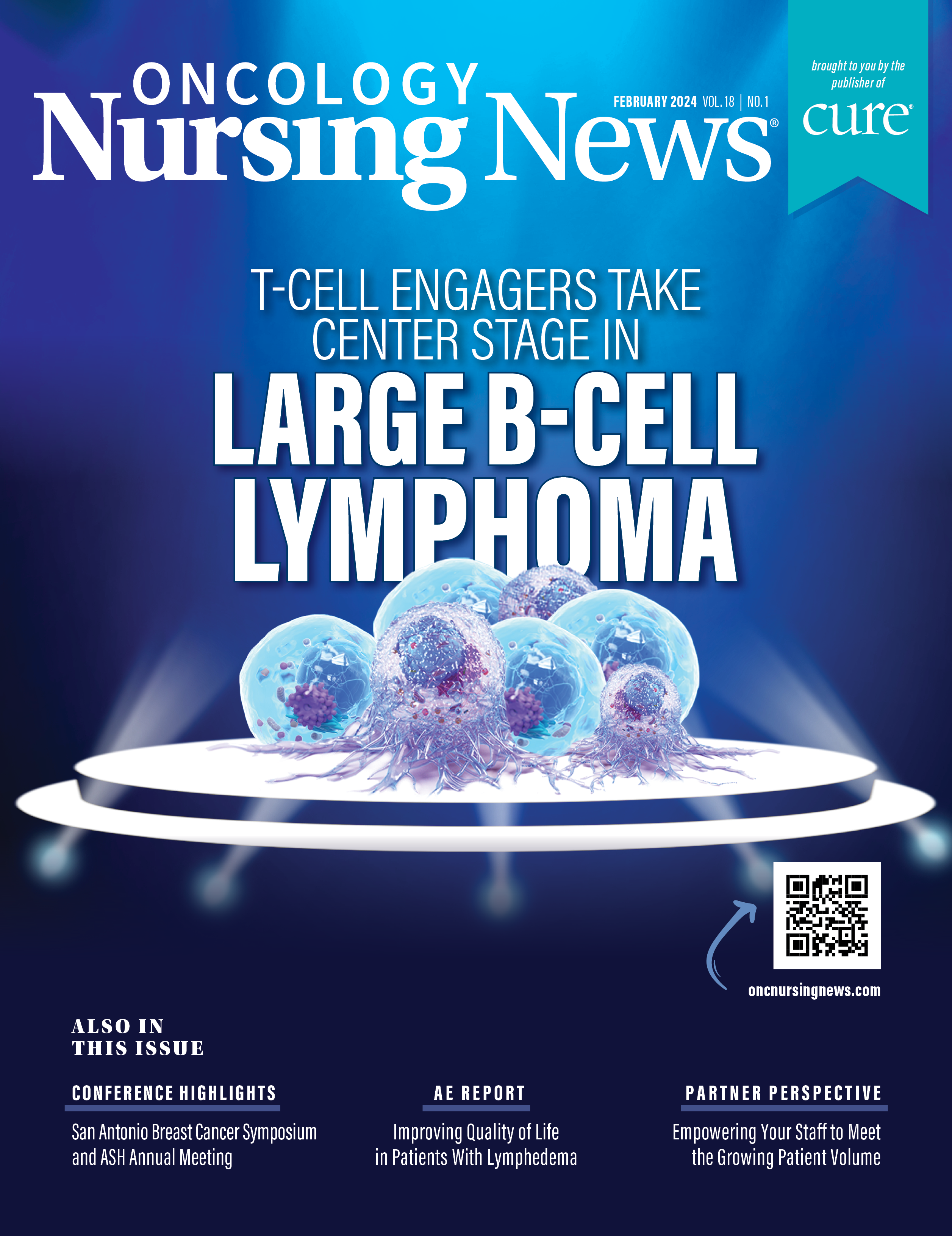Oral SERDs: Shifting the Outpatient Landscape of Metastatic Breast Cancer?
With a new approval for elacestrant, patients with ER+/HER2–, ESR1-mutated metastatic breast cancer have an oral alternative to fulvestrant.
For patients with locally advanced or metastatic estrogen receptor (ER)–positive, HER2-negative breast cancer, the recommended frontline standard of care is endocrine therapy, with either aromatase inhibitors or fulvestrant (Faslodex), plus a CDK4/6 inhibitor.1 However, when the disease begins to progress, the cancer becomes endocrine resistant.1 This is usually accompanied by acquired mutations across a number of genes, including ERBB2, NF1, and ESR1.1
For patients who develop an ESR1 mutation, aromatase inhibitors become ineffective as treatment, although other endocrine receptor inhibitors, including selective ER degraders (SERDs) and selective ER modulators (SERMs), can still be beneficial.1 Current guidelines advise that these patients continue to receive endocrine therapy until all endocrine therapies have been exhausted or a visceral crisis occurs, but the progression-free survival (PFS) associated with endocrine therapy is short—approximately 2 months—in patients who have already received a CDK4/6 inhibitor or an mTOR inhibitor.1
Thus there is a need for more endocrine therapies for these patients, explained Sarah Donahue, MPH, NP, in an interview with Oncology Nursing News.
Sarah Donahue, MPH, NP

“There is a need for more endocrine-based therapies. They generally have [fewer] toxicities than chemotherapies, and patients prefer them because they can take them at home and they don’t have to come in as often,” said Donahue, who is a nurse practitioner at the UCSF Helen Diller Family Comprehensive Cancer Center in San Francisco, California. “There’s a big push for having more of these endocrine-based therapies.”
A New Agent Is Approved
Tamoxifen and toremifene (Fareston) are SERMs that are approved for this patient population.2 But for the past 20 years, the only SERD approved for patients with hormone receptor–positive metastatic breast cancer was fulvestrant. However, in early 2023, the FDA approved elacestrant (Orserdu) for the treatment of men or postmenopausal women with ER-positive, HER2-negative, ESR1-mutated advanced or metastatic breast cancer who experience disease progression after at least 1 line of endocrine therapy. Unlike fulvestrant, elacestrant is an oral therapy.2,3
The regulatory decision was supported by findings from the phase 3 EMERALD trial (NCT03778931), a randomized, open-label, active-controlled, multicenter trial with 478 participants. All participants had advanced or metastatic breast cancer, and 228 had ESR1 mutations.3
To be eligible for the trial, patients needed to have progressed beyond 1 or 2 prior lines of endocrine therapy, including 1 line containing a CDK4/6 inhibitor. Patients were permitted to have received up to 1 prior line of chemotherapy in the advanced or metastatic setting.3
Both in the intention-to-treat (ITT) population and in the patients with ESR1 mutations, significant improvements in PFS were reported. However, an exploratory analysis of PFS in the patients without ESR1 mutations demonstrated an HR of 0.86 (95% CI, 0.63-1.19), suggesting that the ESR1-mutated population was driving the PFS improvement in the ITT population.3
Ultimately, the median PFS in the ESR1-mutated population was 3.8 months (95% CI, 2.2-7.3) with elacestrant (n = 115) vs 1.9 months (95% CI, 1.9-2.1) in the fulvestrant/aromatase inhibitor cohort (HR, 0.55; 95% CI, 0.39-0.77; P < .0005).3
Donahue explained that the first line of treatment for this patient population would normally be an aromatase inhibitor with a CDK4/6 inhibitor, although patients can also undergo frontline treatment with fulvestrant. Three CDK4/6 inhibitors are currently approved; however, cancer, by nature, is adaptable, and once it mutates to become resistant to those CDK4/6 inhibitors, providers have to find a new therapy to offer, she said.
Of note, in the trial, all patients derived some degree of benefit with elacestrant. Because of that, Donahue is optimistic about the agents’ use going forward.
“Despite the improvement for all patients, the FDA only approved it for those with an ESR1 mutation because their improvement in PFS was so much more significant,” Donahue reflected. “Maybe, eventually, it will be approved for all patients with hormone receptor–positive breast cancer, but we will have to wait and see. Right now, it is only approved for that ESR1 population.”
In Clinical Practice
Elacestrant is a nonsteroidal oral SERD that “degrades the ER α in a dose-dependent manner and inhibits estradiol-dependent ER-directed gene transcription and tumor growth in in vitro and in vivo preclinical models, including those harboring ESR1 mutations associated with endocrine resistance.”2
The recommended dose for elacestrant is one 345-mg tablet daily, with or without food, although the label advises that patients may reduce potential nausea and vomiting by taking it with food. It should be taken at approximately the same time each day, and it should be swallowed whole.4
In terms of bedside nursing, the prescribing label noted that the most common adverse events (AEs) with this agent were musculoskeletal pain (41%), nausea (35%), increased cholesterol level (30%), increased aspartate aminotransferase level (29%), increased triglycerides level (27%), fatigue (26%), decreased hemoglobin level (26%), vomiting (19%), increased alanine aminotransferase level (17%), decreased sodium level (16%), increased creatinine level (16%), decreased appetite (15%), diarrhea (13%), headache (12%), constipation (12%), abdominal pain (11%), hot flush (11%), and dyspepsia (10%).4
Moreover, there is a warning for dyslipidemia, because elacestrant may cause hypercholesterolemia and hypertriglyceridemia. The label advises that health care professionals monitor their patient’s lipid profiles “prior to starting treatment and periodically thereafter.”4
However, in Donahue’s experience, the AEs are relatively easy to manage. “They tolerate the agent well,” she said. “There is a little bit more fatigue and a little bit more nausea in patients, but the nausea is all low grade and easy to manage. The fatigue [is] low grade as well.”
When to Test for ESR1
As Donahue explained, ESR1 is a somatic, rather than a germline, mutation. Therefore, providers should be testing for ESR1 when their patient’s disease progresses.4
“This is a mutation where the estrogen receptor can function even in the presence of an aromatase inhibitor, and patients develop this over time,” she said. “It is not a mutation that they get from their parent; it is something that their body mutates during their life and during the course of taking an aromatase inhibitor.”
She added, “You would not test for ESR1 at baseline or before the patient has received an aromatase inhibitor. It is something that you test for at the time of progression.”
Further, ESR1 can be identified through either tissue or liquid biopsy. “[For instance,] if the patient has a growing liver tumor, you can go in and get a tissue biopsy and test,” Donahue said. “You can also check for ESR1 mutations by doing a liquid biopsy, which is taking a sample of blood and looking for circulating DNA from the cancer cells. That is one of the mutations that general tests detect well, it is in most of the panels, and it is not particularly difficult, in my opinion.”
Shifting to Oral Oncolytics
Perhaps the most exciting aspect of this approval is that it allows patients to opt out of intramuscular fulvestrant injections, which can be quite painful. Donahue shared that SERDs are highly effective therapies that allow patients to continue deriving benefit from CDK4/6 inhibitors for years. Now that there is an oral option for some patients, she is optimistic about how that can help those individuals improve their quality of life.
“They can be on fulvestrant for years, along with their CDK4/6 inhibitors, but the injections…can, over time, cause scarring and discomfort,” she said. “It is nice to have an option for those patients [who don’t] require an injection…. Fulvestrant is a medication that is given as an injection; it is intramuscular. It’s given once a month, but it is a pretty big injection [that] can be quite painful. The difference with elacestrant is that it is oral.”
Of note, Donahue acknowledged that it can be uncomfortable for breast cancer providers to give hormone therapy as monotherapy and that she normally reserves those monotherapies for patients with lots of comorbidities.
“We [usually] do not give hormone therapy [alone] anymore,” she explained. “First line is endocrine therapy with CDK4/6 inhibitors, and second line is endocrine therapy with an mTOR inhibitor or with a PI3K inhibitor. We always do a doublet type of thing. I don’t use endocrine therapy as monotherapy often.”
However, there are ongoing studies evaluating the efficacy of elacestrant paired with a targeted therapy. According to Donahue, if these findings prove positive, they will really promote the takeoff of elacestrant use in clinical practice and providers will be more likely to prescribe it to their patients.5,6
There may be other oral SERDs on the horizon. Camizestrant, amcenestrant, and giredestrant are being evaluated in the phase 2 SERENA-2 (NCT04214288), AMEERA-3 (NCT04059484), and acelERA (NCT04576455) trials, respectively.7 Donahue said she is optimistic that this class of drugs will change the landscape.
“I’m really, really excited about the oral SERDs,” she concluded. “It is great that they showed that elacestrant had better PFS than fulvestrant. I’m hoping the other ones in development will, too, and that this new class of drugs becomes further integrated into practice."
References
- Bidard FC, Kaklamani VG, Neven P, et al. Elacestrant (oral selective estrogen receptor degrader) versus standard endocrine therapy for estrogen receptor-positive, human epidermal growth factor receptor 2-negative advanced breast cancer: results from the randomized phase III EMERALD trial. J Clin Oncol. 2022;40(28):3246-3256. doi:10.1200/JCO.22.00338
- Hormone therapy for breast cancer. American Cancer Society. Accessed December 20, 2023. https://www.cancer.org/cancer/types/breast-cancer/treatment/hormone-therapy-for-breast-cancer.html
- FDA approves elacestrant for ER-positive, HER2-negative, ESR1-mutated advanced or metastatic breast cancer. FDA. January 27, 2023. Accessed December 20, 2023. https://www.fda.gov/drugs/resources-information-approved-drugs/fda-approves-elacestrant-er-positive-her2-negative-esr1-mutated-advanced-or-metastatic-breast-cancer
- Orserdu. Prescribing information. Stemline Therapeutics Inc; 2023. Accessed December 20, 2023. https://www.accessdata.fda.gov/drugsatfda_docs/label/2023/217639s000lbl.pdf
- Open-label umbrella study to evaluate safety and efficacy of elacestrant in various combination in patients with metastatic breast cancer (ELEVATE). ClinicalTrials.gov. Updated December 11, 2023. Accessed December 20, 2023. https://clinicaltrials.gov/study/NCT05563220
- Phase Ib/II trial of abemaciclib and elacestrant in patients with brain metastasis due to HR+/HER2- breast cancer. ClinicalTrials.gov. Updated July 12, 2023. Accessed December 20, 2023. https://clinicaltrials.gov/study/NCT04791384
- Wong NZH, Yap DWT, Ong RJM, et al. Efficacy of oral SERDs in the treatment of ER+, HER2- metastatic breast cancer, a stratified analysis of the ESR1 wild type and mutant subgroups. Ann Oncol. Published online October 21, 2023. doi:10.1016/j.annonc.2023.10.122




